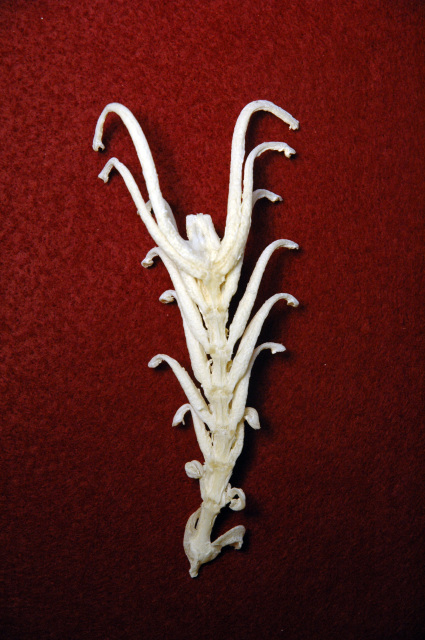
What you are looking at is a dog sternum. The cartilage surrounding it is malleable if you soak in warm water, and then you can pin it into a new position to dry. As an added bonus, no Fish & Wildlife inspection fee is required for international shipping. Yours, for $7.00.
Aside from being educational ( if not a little flip), we use this picture as a segue into HRDs (Human Remains Detection Dogs), also known as cadaver dogs. While no specific breeds are identified with this type of work, the majority of these highly trained dogs are Labrador Retrievers or German Shepherd Dogs.
Aside from the training, teaching a cadaver dog is challenging for another reason. Drug dogs are trained on drugs, and explosives dogs are trained on the scent of ammonium nitrate, black powder, and dynamite, etc., but what does a cadaver dog train on?
Training an HRD requires regular contact with human blood, decaying flesh and bones. In the United States, dog handlers can legally obtain bodily components like human bones, placenta and blood, but not easily. Volunteers get material anywhere they can, and trainers have been known to resort to using their own blood or pulled teeth. In fact, it’s said that no one knows sharing like a cadaver dog handler. One article we read half jokingly referred to the black humor of such handlers: “Dude! I’m sorry you cut the end of your finger off. Can I have it?” “Hey, because you’re my sister, and I know you love me, can I have the placenta after the baby is born?”
There are commercially available odors (the most common is Sigma Pseudo Corpse Scent which comes in, “recently dead,” “decomposed,” and drowned), but deceased humans produce unique volatile organic compounds, and with a dog’s exquisitely sharp sense of smell, it’s not quite the same thing.
And this brings us back to the dog’s sternum. It’s sold by the Bone Room, a 30 year old California business that specializes in natural science and “all things once living” (Skulls Unlimited is another such business). Human and animal skulls and skeletons, genuine fossils, quality bone and fossil cast replicas, framed insects, and more are sold here, and HRD trainers are often customers. The bones aren’t ideal, but as someone said in an on-line forum we visited, they’re better than nothing.
And for anyone who is wondering, it is legal to possess and sell human bones in the United States, though there are exceptions: Archaeological items protected by the Native American Graves Protection and Repatriation Act (1990), and in states that have banned import and export: Georgia, Tennessee, and New York.
Does this all sound ghoulish? Maybe. The value of the work done by an HRD dog, however, can’t be overestimated. Not only do these dogs detect evidence and help bring closure to families, they can prevent crimes by putting law enforcement on alert. How? In one case, a medical examiner asked an HRD to return to an area to find a missing throat bone to help determine if the victim had been strangled. The dog found a rib, instead. This perplexed (and alarmed) the medical examiner because he already had all the ribs from the original victim. The find meant that there was a second victim, and the case became a serial killing. Police were now looking at a different kind of criminal.
It’s in everyone’s best interest that cadaver dogs are trained, and properly so. In all seriousness, if one is considering donating one’s body to science, one might consider donating it to the education of forensic anthropologists, and those who train cadaver dogs. Read more about that here.
